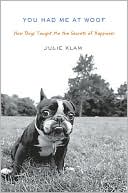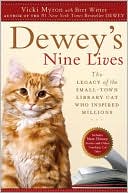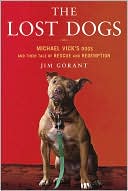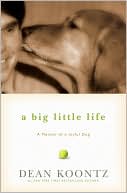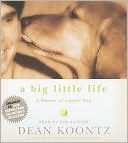Cat People
With characteristic wit, self–effacing charm and sheer, exuberant love of a good cat story, New York Times bestselling author Michael Korda and his wife Margaret Korda recount their lives as "cat people," beginning with Margaret's passion for cats (and Michael's reluctant mid–life transformation into a cat person), and introducing readers to a hilarious assortment of people whose life revolves––often to an extraordinary degree––around their cat, or cats, from Cleopatra a transatlantic...
Search in google:
With characteristic wit, self–effacing charm and sheer, exuberant love of a good cat story, New York Times bestselling author Michael Korda and his wife Margaret Korda recount their lives as "cat people," beginning with Margaret's passion for cats (and Michael's reluctant mid–life transformation into a cat person), and introducing readers to a hilarious assortment of people whose life revolves––often to an extraordinary degree––around their cat, or cats, from Cleopatra a transatlantic traveler who found happiness in Paris to Wally, the epitome of feline dignity.Here are people who just can't say no to another cat, who "world–travel" with their cat, who build their social life around their cats––and of course the cats themselves, for the Kordas celebrate the beguiling power of cats, including many of their own, who have complemented, complicated and changed their lives together over the years. Here are charming, often hilarious and sometimes sad portraits of such cats as Margaret's beloved Irving, whose favorite abode was the Beverly Wilshire Hotel, and Mumsie, who arrived unexpectedly at the door with her two kittens, and special cats like Jake and the gentle Chutney, as well as "difficult" cats like Chui and poor Mrs. Bumble, and Mr. McT., the bully who found love late in life. Here are graceful cats and cats like Kit–Kat that never look before they jump, in short, countless cats the reader will never forget, even those with many cats of their own. Publishers Weekly Michael Korda, Simon & Schuster's editor-in-chief, has already written about the bond between humans and animals in his acclaimed Horse People, but now he and his wife offer a personal look at their infatuation with cats. The story begins before their marriage, with each having their own first cat experiences, and moves forward as they marry and begin to add cat after cat to their home. Starting with Margaret's cat, Irving, each feline's story and quirks are detailed as they move onto the Kordas' farm. The three-legged Queenie, hunter Mumsie and the amorous Mr. McTavish all receive their own chapters that document their lives. It would be easy to see this book as a vanity project penned by two cat-besotted people, but the addition of historical and philosophical anecdotes makes it more than that. From Churchill's insistence on asking the opinion of his cat Nelson during admiralty meetings to the parable of Mallarm 's cat, these tangents transform the Kordas' story into a humorous and insightful look at just how consuming cats can be for their owners. For those who have experienced what the Kordas call "cat-harsis," this book will be a fun and often hilarious read. B&w illus. Agent, Lynn Nesbit. (Nov.) Copyright 2005 Reed Business Information.
Cat People\ \ By Michael Korda \ HarperCollins Publishers, Inc.\ Copyright © 2005 Michael Korda\ All right reserved.\ ISBN: 0060756632 \ \ \ Chapter One\ \ Of Cats and People\ \ Cats and people have lived together for a very long time, ever since humankind turned from hunting and gathering, for the former of which pursuits dogs were useful, to settled agriculture, for which protecting the harvested grain and seed from rodents began to matter more.\ Large members of the cat family were a predatory menace to early humans (and of course still are in parts of Africa, Siberia, and India), but the smaller members of the cat family no doubt made themselves noticed around the campfires of our remote ancestors by their proficiency at killing mice and rats.\ Perhaps just as important for both species, cats do not at any point in human history seem to have been thought edible. On the subject of dogs, tastes vary, but American Indians prized them highly as food, and usually boiled a puppy as a treat for esteemed visitors; Polar explorers in an emergency have eaten their sled dogs, though no doubt with regret; and dogs still play a part (albeit one that most Americans and Europeans would rather ignore) in Chinese haute cuisine. Cats, on the other hand, are not normally on anybody's menu, and so far as one can tell, never have been.\ That was good news for cats, right from the beginning. Not, by nature, particularly trusting creatures -- in the wild, they are amiable, curious, but cautious -- at least in their relationship with humans they were spared the pot, except in the extreme circumstances of great sieges, in which besieged city-dwellers were reduced to eating dogs, rats, and their own boots, before turning to cats as a last resort.\ Since cats made themselves useful by killing rodents, exercised, groomed, and fed themselves, and were, as animals go, exceptionally clean and tidy in their habits, even fastidious, it is hardly surprising that humans accepted them quickly into their domestic environment, surely noting, from the beginning, that cats were not on the whole looking for a leader or master, and indeed had an independent and fairly haughty view of themselves, and their place in the world.\ Dogs are animals of the pack, eager to follow a leader, and even willing to accept a human being in that position, provided he or she feeds them. Cats are independent -- leadership is not high on their list of demands -- and it must have been quickly apparent that no cat was likely to look up at a human being with an adoring, trusting, or soulful expression in its eyes, or do anything on command.\ Dogs can also be taught a great deal, and most of them enjoy learning -- certainly they enjoy being praised -- but cats have no interest in learning at all, what they do is done by instinct, and they do not seem to feel they have anything to learn from people, nor does their day generally depend on whether they have been praised or not. Cats don't do tricks to please their owner -- if they do anything resembling a trick, it's to please and amuse themselves.\ It is hardly surprising that the Egyptians, with their economy dependent on intensive agriculture and storage of grain, came early on to treat cats as godlike figures. Aloof, beautiful, mysterious, able to see in the dark, fierce but apparently passionless killers, who toyed with the creatures they intended to kill as the gods toyed with humans' lives, cats played a huge role in Egyptian iconography and art, far beyond their importance as rodent killers in the grain storage bins of the kingdom. The catlike eyes, slender figures, and long necks in the portraits of the Egyptian queens make it clear enough that cats were worshipped and imitated for their beauty as much as for their usefulness. The highest form of human beauty in ancient Egypt was to resemble a cat, and cats themselves sometimes wore collars of gold and precious stones.\ Of course the cat's nature does not inspire universal love. Those who crave obedience from an animal are unlikely to appreciate cats as pets -- they do not heel, or roll over and play dead, or hold out a paw on command -- and the world since ancient Egypt has therefore been divided between cat lovers and those who can't abide cats. Not that cats mind much. They have their own agenda, and like to stick to it.\ Perhaps this spirit of independence, and the fact that they remain, even when domesticated, essentially wild, is what gives them their remarkable powers of survival -- the proverbial nine lives. When it comes to independence, survival skills, loyalty to your own kind, and unconditional love, we humans have much to learn from cats.\ We live in rural Dutchess County, where winters are long and hard, and there is never any shortage of stray or abandoned cats in the woods and fields around our house. Many of them look scrawny, underfed, and resentful -- one guesses that most of them have been thrown out of a comfortable life in somebody's house or trailer into the wild for one reason or another -- but a surprising number of them survive, as we shall see, living in drains, or old barns, and foraging for their food.\ Dogs, of course, can survive in the wild too, except perhaps for the smaller, more decorative species, but they usually need to form or join a pack to do so, whereas cats seem to slip effortlessly back to wildness when they have to, leading solitary lives in harsh conditions. Most of our cats, in fact, have emerged from the woods to the front door or the porches, become accustomed to finding a bowl of food put out for them, then made the transition from strays, to "outside" cats, who hang around the property, then to becoming "barn cats," who live in the barn and do a little light mousing and ratting to earn their keep, and finally get promoted to "house cat" status, settling down on the chairs and sofas as if they had never roamed wild through the winter or hunted for their dinner.\ \ Continues...\ \ \ \ Excerpted from Cat People by Michael Korda Copyright © 2005 by Michael Korda.\ Excerpted by permission.\ All rights reserved. No part of this excerpt may be reproduced or reprinted without permission in writing from the publisher.\ Excerpts are provided by Dial-A-Book Inc. solely for the personal use of visitors to this web site. \ \
\ Shawna Seed"The Kordas have found the perfect mixture of whimsy and humor."\ \ \ \ \ Kitty Kelly"This is a purrrrrrfect read!"\ \ \ Barbara Delinsky"I have savored Cat People. It’s just wonderful. What a treat! It is totally entertaining—amusing, charming, touching, and insightful."\ \ \ \ \ Rita Mae Brown"Reading Cat People proves how very intelligent you are. Most importantly, you will impress your cat."\ \ \ \ \ Publishers WeeklyMichael Korda, Simon & Schuster's editor-in-chief, has already written about the bond between humans and animals in his acclaimed Horse People, but now he and his wife offer a personal look at their infatuation with cats. The story begins before their marriage, with each having their own first cat experiences, and moves forward as they marry and begin to add cat after cat to their home. Starting with Margaret's cat, Irving, each feline's story and quirks are detailed as they move onto the Kordas' farm. The three-legged Queenie, hunter Mumsie and the amorous Mr. McTavish all receive their own chapters that document their lives. It would be easy to see this book as a vanity project penned by two cat-besotted people, but the addition of historical and philosophical anecdotes makes it more than that. From Churchill's insistence on asking the opinion of his cat Nelson during admiralty meetings to the parable of Mallarm 's cat, these tangents transform the Kordas' story into a humorous and insightful look at just how consuming cats can be for their owners. For those who have experienced what the Kordas call "cat-harsis," this book will be a fun and often hilarious read. B&w illus. Agent, Lynn Nesbit. (Nov.) Copyright 2005 Reed Business Information.\ \ \ \ \ Library JournalHaving deciphered the equine world in their Horse Housekeeping: How To Keep a Horse at Home and in Michael's Horse People, the Kordas now turn their attention to cats and their passionate human devotees. Actually, the title is rather misleading; while there are amusing anecdotes about obsessive ailurophiles (like the couple who order kitty litter by the truckload for their 23 cats), this book is primarily about the many felines, mostly strays, who have come into the Kordas' lives, from faithful Irving, Margaret's cat from her first marriage; to imperious three-legged Queenie, named after Michael's aunt, the actress Merle Oberon; and the thuggish Mr. McTavish. While entertaining, the text is a bit repetitive, as if the authors were trying to pad what really should be a magazine article (perhaps for Animal Fair?). Still, cat people are endlessly fascinated by these mysterious creatures, so there will be demand. As Simon & Schuster editor in chief Michael Korda well knows, cat books always sell. [See Prepub Alert, LJ 7/05.]-Wilda Williams, Library Journal Copyright 2005 Reed Business Information.\ \

